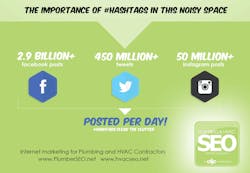Latest from Best Practices
Sponsored
Online Exclusive: Hashtag importance in Internet marketing
There is a lot more to social media marketing that setting up a Facebook, Twitter or Google+ account and posting on it once a week. In order to have success in this intriguing — and often misunderstood — marketing space, you have to know the basics.
There are many details that go into social media marketing, but today we are going to talk about the most confusing of all, the Hashtag! I know you have seen them before, they are words preceded with the pound sign (#). For those just getting started in social media marketing, the Hashtag is often overlooked.
However, Hashtags are a powerful tool to being found in the noisy social media space. The Hashtag begun and gained its popularity through Twitter. It was used as a way to stand out, be found, and communicate online. In fact, tweets that use Hashtags get double the engagement than those without, that’s because Hashtags allow you to organize discussions based on specific keywords.
For instance, let’s say you were tweeting about a specific model of water heater and some of its benefits. Your tweet would look something like this:
“The AO Smith FCG-74 has a Permaglass Glass Coating which protects against rust #AOSmith #WaterHeaters #FCG74”
Keep in mind that your hashtags have to fall within the character limit, and must be one word. So even if your hashtag is multiple words, like in our example with water heaters, they must be grouped together.
To continue the discussion about Internet marketing, go to our new Plumbing Talk forum.
If they are multiple words, it is best to capitalize the first letter of each word. This is important because the words become easier to read and will lead your tweet to come up whenever someone decides to do a search on Water Heaters or AO Smith.
Numbers are also supported in hashtags, as you can see, I was able to hashtag the model number #FCG74. Notice I did not add the dash that AO Smith uses in the model number FCG-74, that’s because dashes, commas, periods, question marks, exclamation points, ampersands, asterisks and apostrophes cannot be used in Hashtags.
The @ symbol can be used in Twitter but not within a hashtag, it is used in front of a twitter name as a way to directly message another twitter user, for instance, @plumberSEO.
Where are hashtags used?
The hashtag originated in Twitter, and this is where it is still the most relevant, however, other social media outlets have begun to implement the hashtag as well.
The most popular of all social media sites, Facebook, implemented the use of hashtags in June 2013. When you click on a Facebook hashtag, it will bring you to a list of posts that share the same hashtag, allowing you to find similar posts that dwell within a social circle that is outside of your friends.
Instagram is a photo-sharing app used mostly through smart phones. You can snap photos and drop cool filters on them to turn them into works of art. Or simply take a photo of a new faucet installation and follow it up with a hashtag such as “#MoenFaucets.”
In my eyes, Google+ is one of the most important social networking sites to be on. Mainly for its tight integration with Google search and Authorship markup. Google+ has hashtags that allow you the option to search within Facebook and Twitter.
Pinterest has morphed into a very popular social media site over the years. With a strong female population, Pinterest is a virtual pinboard for sharing photos that are organized into groups referred to as boards. Hashtags are very popular here for search related applications.
How should we be using hashtags?
Aside from our water heater example earlier in the article, here are some more ideas:
·On Facebook: Using a team photo — “A Photo of a growing team. #PowerPlumbingPros #Plumbers”
·On Instagram: Photo of a broken pipe at the customer’s location — “Burst pipe needs some love #Fail”
·On Tumblr: An article about the advantages of tankless water heaters — “#TanklessWaterHeaters #Plumbers”
·On Pinterest: Photo of a beautiful new kitchen — “Plumbing is a major part of creating a beautiful kitchen #KitchenFaucet #KitchenRemodel”
Dean Iodice is one of the authors of the groundbreaking book, “Internet Marketing & SEO For Contractors.” He is also president of ContractorSEO and PlumberSEO, which specializes in helping contractors and Plumbers across the U.S. increase their sales and revenue via effective online marketing. Learn more at www.contractorseo.net or www.plumberseo.net. Contact Dean at 866-493-9910 or [email protected].






